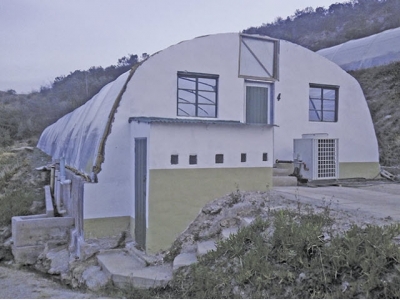Fish farming – coping with heat

An increase in water temperature means a depletion in oxygen levels. How do tunnel-based fish farms cope with extreme heat and ensure that fish receive their required oxygen levels?
End-wall roof vents let out much of the accumulated heat build-up in a tunnel system. Photo: Nicholas James
The weather over the Christmas period was exceptionally hot across most of South Africa. In the Eastern Cape, we experienced temperatures well into the 30s, coupled with high humidity, for three weeks. This poses all sorts of difficulties for tunnel-based fish farms. The problem is particularly severe in the Lowveld and provision for cooling is essential here.
Tunnels used in aquaculture typically elevate water temperatures by 6°C to 7°C over ambient. Thus, with no ventilation, water temperatures can rise into the mid-30s or higher. An unventilated tunnel can experience air temperatures of above 50°C. Such levels, coupled with the 100% humidity, make for very unpleasant working conditions. And if you think you’re suffering, the fish are having a worse time.
Although most tilapia species thrive in water of around 30°C, they do not do well if the oxygen content is low. Water at 32°C holds half the oxygen of water at 22°C. It is usually accepted that an oxygen content of between 4mg/l and 6mg/l is sufficient for tilapia. (Trout need over 6mg/l to survive).
At elevated temperatures, oxygen can decline to as low as 2mg/l to 3mg/l, which severely stresses tilapia.
In green water systems, the photosynthesis of the algae will raise oxygen levels during the day, sometimes to saturation level, but reduce them at night – almost to lethal levels – when the algae take in oxygen and give off carbon dioxide.
If the tanks are lightly stocked, that is <10kg/ m3 water, problems are unlikely to occur. However, at high stocking rates of between 25kg/ m3 water and 35kg/ m3 water, typical of many recirculating systems, oxygen depletion is very likely at a high water temperature. It is not usually the high temperature per se that kills the fish, but the lack of oxygen.
Problem signs include fish mouthing the surface near water inlets, especially shortly after feeding. Mass gasping at aeration points is a clear warning signal that urgent action must be taken.
Cooling methods
Ventilation: Every aquaculture tunnel should have the potential to be ventilated. Traditional agricultural tunnels have various methods of ventilation, including end vents, roll-up sides and roof vents. Where possible, a tunnel should be placed end-on to the prevailing wind. This allows for good ventilation and maximum resistance against strong winds. Windows situated at the tunnel ends can be fitted with high-volume fans to force in cooler air.
Flushing: A bulk water supply in the form of a dam or large reservoir, or water that can be pumped from a borehole in times of emergency, should be available. Flushing the tanks with cooler water not only serves to lower the water temperature, but removes metabolic wastes and allows the oxygen level to rise due to the reduced biological oxygen demand. A higher oxygen level also increases filtration efficiency.
Water systems: Distinguishing between clear and green water systems is important. In green water systems, oxygen levels are higher when stocking levels are low due to photosynthesis by algae, but these systems are very risky when stocking levels are increased. Clear water recirculating systems are more stable, and also allow for easier monitoring of fish behaviour.
Related news
 Seaweed supplementation said to boost immunity in fish
Seaweed supplementation said to boost immunity in fish Adding supplemental seaweed to farmed fish diets could boost immune functioning and antioxidant responses.
 How to start your own aquaculture business – part 2
How to start your own aquaculture business – part 2 In this second instalment of our series on launching an aquaculture business, we look at what steps to follow once a beginner has secured a basic knowledge
 How to start your own aquaculture business – Part 3
How to start your own aquaculture business – Part 3 In the last two articles, we examined the road to be taken by starter fish farmers with little or no experience.